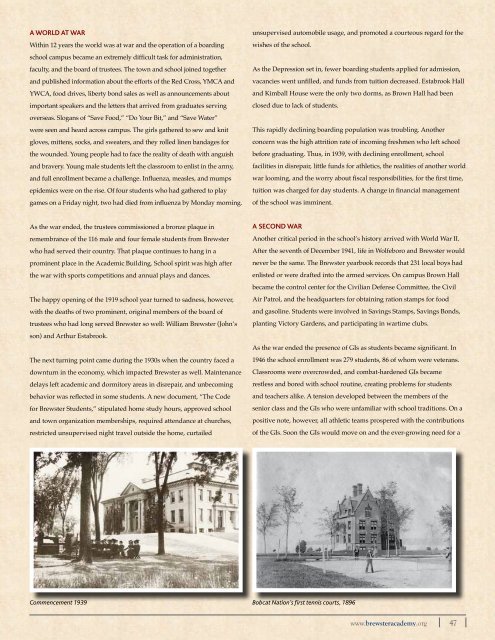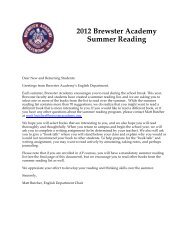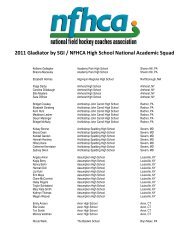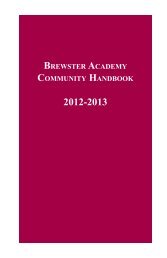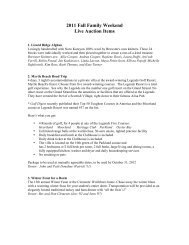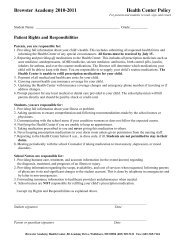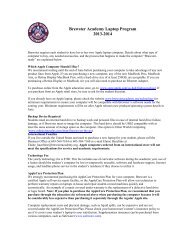BrewsterConnections(PDF) - Brewster Academy
BrewsterConnections(PDF) - Brewster Academy
BrewsterConnections(PDF) - Brewster Academy
You also want an ePaper? Increase the reach of your titles
YUMPU automatically turns print PDFs into web optimized ePapers that Google loves.
A World at War<br />
Within 12 years the world was at war and the operation of a boarding<br />
school campus became an extremely difficult task for administration,<br />
faculty, and the board of trustees. The town and school joined together<br />
and published information about the efforts of the Red Cross, YMCA and<br />
YWCA, food drives, liberty bond sales as well as announcements about<br />
important speakers and the letters that arrived from graduates serving<br />
overseas. Slogans of “Save Food,” “Do Your Bit,” and “Save Water”<br />
were seen and heard across campus. The girls gathered to sew and knit<br />
gloves, mittens, socks, and sweaters, and they rolled linen bandages for<br />
the wounded. Young people had to face the reality of death with anguish<br />
and bravery. Young male students left the classroom to enlist in the army,<br />
and full enrollment became a challenge. Influenza, measles, and mumps<br />
epidemics were on the rise. Of four students who had gathered to play<br />
games on a Friday night, two had died from influenza by Monday morning.<br />
unsupervised automobile usage, and promoted a courteous regard for the<br />
wishes of the school.<br />
As the Depression set in, fewer boarding students applied for admission,<br />
vacancies went unfilled, and funds from tuition decreased. Estabrook Hall<br />
and Kimball House were the only two dorms, as Brown Hall had been<br />
closed due to lack of students.<br />
This rapidly declining boarding population was troubling. Another<br />
concern was the high attrition rate of incoming freshmen who left school<br />
before graduating. Thus, in 1939, with declining enrollment, school<br />
facilities in disrepair, little funds for athletics, the realities of another world<br />
war looming, and the worry about fiscal responsibilities, for the first time,<br />
tuition was charged for day students. A change in financial management<br />
of the school was imminent.<br />
As the war ended, the trustees commissioned a bronze plaque in<br />
remembrance of the 116 male and four female students from <strong>Brewster</strong><br />
who had served their country. That plaque continues to hang in a<br />
prominent place in the Academic Building. School spirit was high after<br />
the war with sports competitions and annual plays and dances.<br />
The happy opening of the 1919 school year turned to sadness, however,<br />
with the deaths of two prominent, original members of the board of<br />
trustees who had long served <strong>Brewster</strong> so well: William <strong>Brewster</strong> (John’s<br />
son) and Arthur Estabrook.<br />
The next turning point came during the 1930s when the country faced a<br />
downturn in the economy, which impacted <strong>Brewster</strong> as well. Maintenance<br />
delays left academic and dormitory areas in disrepair, and unbecoming<br />
behavior was reflected in some students. A new document, “The Code<br />
for <strong>Brewster</strong> Students,” stipulated home study hours, approved school<br />
and town organization memberships, required attendance at churches,<br />
restricted unsupervised night travel outside the home, curtailed<br />
A Second War<br />
Another critical period in the school’s history arrived with World War II.<br />
After the seventh of December 1941, life in Wolfeboro and <strong>Brewster</strong> would<br />
never be the same. The <strong>Brewster</strong> yearbook records that 231 local boys had<br />
enlisted or were drafted into the armed services. On campus Brown Hall<br />
became the control center for the Civilian Defense Committee, the Civil<br />
Air Patrol, and the headquarters for obtaining ration stamps for food<br />
and gasoline. Students were involved in Savings Stamps, Savings Bonds,<br />
planting Victory Gardens, and participating in wartime clubs.<br />
As the war ended the presence of GIs as students became significant. In<br />
1946 the school enrollment was 279 students, 86 of whom were veterans.<br />
Classrooms were overcrowded, and combat-hardened GIs became<br />
restless and bored with school routine, creating problems for students<br />
and teachers alike. A tension developed between the members of the<br />
senior class and the GIs who were unfamiliar with school traditions. On a<br />
positive note, however, all athletic teams prospered with the contributions<br />
of the GIs. Soon the GIs would move on and the ever-growing need for a<br />
Commencement 1939 Bobcat Nation’s first tennis courts, 1896<br />
www.brewsteracademy.org<br />
47


